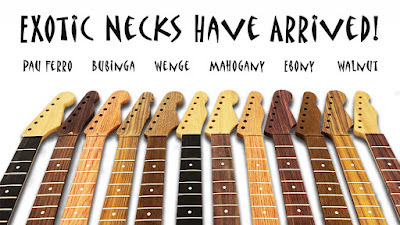The Differences in Timber Used for Guitar Necks
The choice of wood for a guitar neck plays a significant role in the instrument's tone, stability, and playability. Different types of timber influence factors such as resonance, sustain, weight, and even the feel of the neck. Here, we explore some of the most commonly used woods for guitar necks and their characteristics.
1. Maple
Maple is one of the most popular woods for guitar necks, particularly in electric guitars. It is a dense and strong hardwood that offers bright tones with excellent sustain. Maple necks are often used in bolt-on constructions, contributing to a snappy attack and clear articulation.
- Tone: Bright, punchy, with a strong midrange.
- Stability: High resistance to warping.
- Common Uses: Fender Stratocaster, Telecaster, and other bolt-on neck guitars.
- Variants: Hard maple (more stable) and roasted maple (lighter and more resistant to humidity changes).
2. Mahogany
Mahogany is a softer hardwood commonly used in set-neck and neck-through guitar constructions. It is favored for its warm, rich tone with excellent resonance. Mahogany necks often provide a smooth playing feel, making them a staple in Gibson-style guitars.
- Tone: Warm, with strong low-mids and smooth highs.
- Stability: Good, but more sensitive to temperature and humidity changes compared to maple.
- Common Uses: Gibson Les Paul, SG, and PRS guitars.
- Variants: African mahogany (lighter) and Honduran mahogany (denser with more resonance).
3. Rosewood
Rosewood is more commonly used for fretboards, but some guitar necks are made entirely from this wood. Rosewood necks offer a rich, complex tone with additional warmth and sustain. Due to its weight and cost, rosewood necks are less common than maple or mahogany.
- Tone: Warm and resonant with a full-bodied sound.
- Stability: Excellent, but heavy.
- Common Uses: High-end acoustic guitars and some boutique electric guitars.
- Variants: Indian rosewood (most common) and Brazilian rosewood (rarer and highly sought after).
4. Walnut
Walnut is an underrated choice for guitar necks, offering a balanced tone between maple and mahogany. It is moderately dense and provides a strong midrange with articulate highs.
- Tone: Balanced with good sustain.
- Stability: High resistance to warping but heavier than mahogany.
- Common Uses: Custom-built and boutique guitars.
- Variants: Black walnut (common) and Claro walnut (visually striking with tonal depth).
5. Wenge
Wenge is a dense and exotic hardwood that provides excellent stability and sustain. It has a naturally oily texture, making it smooth to play without requiring a finish.
- Tone: Strong low-mids with pronounced articulation.
- Stability: Extremely resistant to changes in humidity.
- Common Uses: High-end and custom guitars, particularly in metal and progressive rock genres.
- Variants: Dark brown with visible grain patterns.
6. Korina (White Limba)
Korina is a lesser-known but highly regarded wood for guitar necks. It offers a warm tone similar to mahogany but with slightly brighter overtones.
- Tone: Warm and dynamic, with enhanced clarity.
- Stability: Good, similar to mahogany.
- Common Uses: High-end and boutique guitars.
- Variants: White limba (brighter) and black limba (darker, more resonant).
Conclusion
Each type of wood used for guitar necks brings unique tonal and structural characteristics to the instrument. Players seeking bright tones and snappy response might prefer maple, while those looking for warmth and richness might choose mahogany or rosewood. More exotic woods like wenge and walnut offer unique tonal properties and visual appeal. The best choice ultimately depends on the player’s preference, playing style, and the overall design of the guitar.
Author:
A Evans


No comments:
Post a Comment